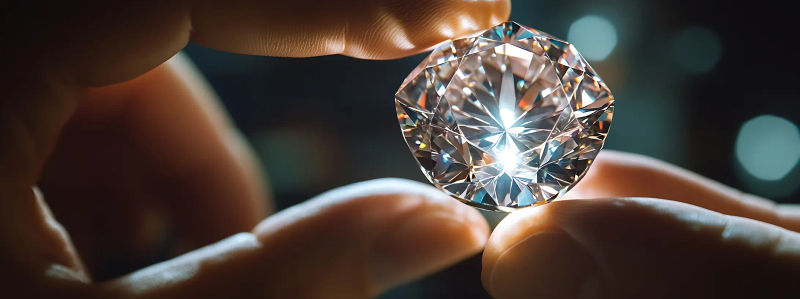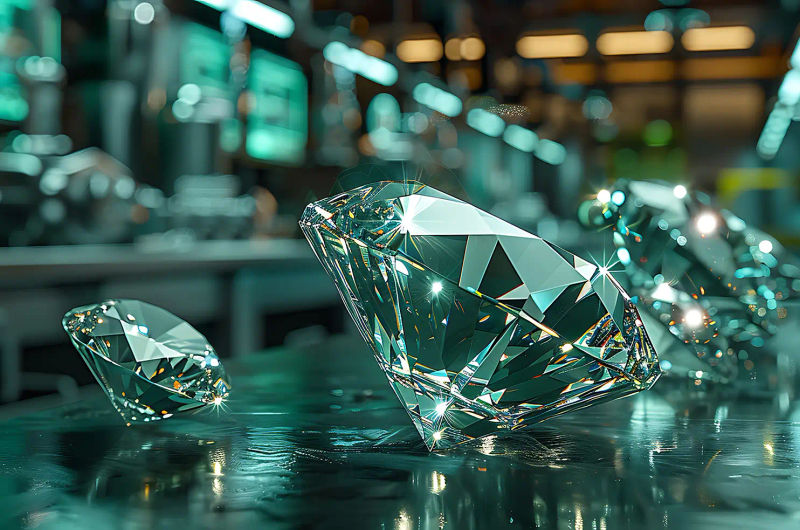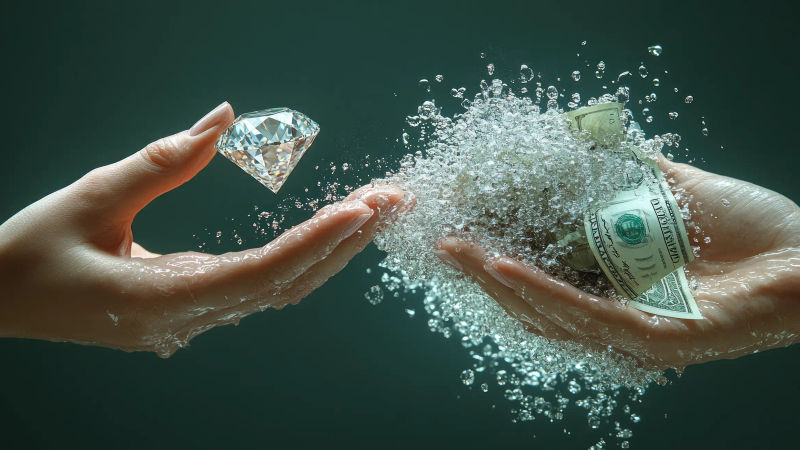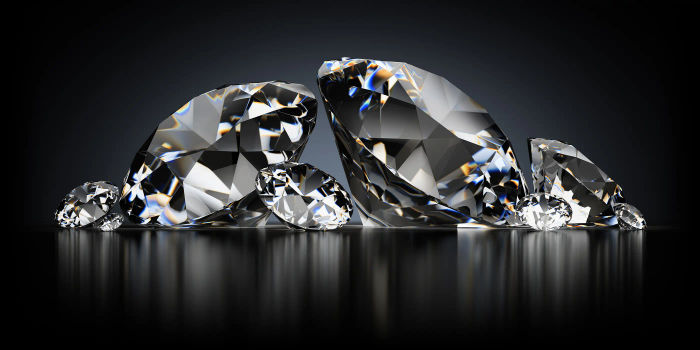In this blog post, we're diving into the fascinating world of diamonds—specifically, lab-grown diamonds versus natural diamonds. With thousands of questions swirling around, we're here to answer them all. We will guide you through the differences, compare prices, and more. Let's get started!
Lab-Grown Diamonds vs Natural Diamonds
What is a Lab Grown Diamond?
We always get asked are lab created diamonds real, and the short answer to this is, yes!
Lab diamonds are real diamonds created similarly to natural diamonds, with the same chemical makeup, only in weeks to months. Mined natural diamonds have been created for millions and billions of years. Because of this, there are some differences between the two. But do not make the mistake of calling a lab grown diamond a fake diamond, as they are not fake diamonds. There are in every way visually, chemically and physically identical to a natural diamond.
To the naked eye, distinguishing between lab-grown and natural diamonds is nearly impossible. To detect the differences we will need to look deeper into the creation of the stone and understand how a natural and lab diamond are created. There are differences here that give the game away to detect lab grown diamonds.

How are Lab Diamonds Created?
There are two ways to create diamonds in a lab, but there is only one way to create natural diamonds. One of the lab diamond processes is CVD, which stands for Chemical Vapour Deposition. CVD involves condensing carbon gases onto an existing carbon matrix called a seed under high heat and pressure. The natural diamond process happens when carbon dioxide is trapped in the earth's mantle with intense heat and pressure. The other method to create diamonds in a lab is HPHT, which stands for High Pressure and High Temperature. Carbon is compressed within a metal cube and subjected to high heat and pressure using electric pulses. Over time, the carbon breaks down and forms a diamond through crystallisation.

CVD Lab-Diamond Creation Process
What Is The Difference Between CVD And HPHT?
The most straightforward answer to this question is nothing. Both produce quality lab-grown diamonds, and it is not possible to distinguish which method produced the diamond. When purchasing a lab-grown diamond, you should not consider the process from which the diamond was grown. The production process of lab grown diamonds are now mostly produced in China and India. Due to cheap labor in these countries, lab grown stones are becoming very cost effective.
Benefits of Lab-Grown Diamonds
Lab-grown diamonds are more environmentally friendly, as their production does not involve the destructive mining processes that can harm ecosystems. They are also conflict-free, ensuring that they are not associated with human rights abuses or unethical practices. Furthermore, lab-grown diamonds can be produced using renewable energy sources, adding to their sustainability. Available in a range of qualities, from low to high, lab-grown diamonds cater to a wide array of consumer preferences and budgets.
How Do You Identify a Lab-Grown From a Natural Diamond?
Growth Patterns In Diamonds vs Naturally occurring diamonds.
While most of the primary growth factors of lab diamond growth are the same between lab and natural diamonds, they also have differences in their growth pattern. One big difference is the direction in which the diamonds grow, which can be detected with different tools and instruments, but those instruments are very expensive. Lab diamonds grow upward, and Earth diamonds grow outward from the centre.
Nitrogen Atoms In Lab Created Diamonds Not Present
The main distinguishing feature between lab diamonds and earth-created diamonds is that lab diamonds typically do not have nitrogen atoms in their molecular Matrix, while Earth-created diamonds usually do. However, a few natural diamonds also lack nitrogen atoms, making detection difficult.
Testing diamonds with Infrared Light Spectroscopy
A lab or jeweller can use infrared light spectroscopy to test a diamond to see if it has nitrogen within it. If the resulting spectroscopy graph shows a diamond has a nitrogen peak, it's almost certainly a real natural diamond. If the spectroscopy graph doesn't have nitrogen, then it likely is a lab diamond, but it could still be an Earth-created diamond that doesn't happen to have nitrogen. So, nitrogen's presence confirms natural diamonds, while its absence can't entirely rule out that it's a natural diamond.
Visual Differences to the Naked Eye between Lab Created Diamonds vs Mined Diamonds
While labs and special instruments can detect all of this, to the naked eye, lab diamonds and Earth-created diamonds are visibly the same. This means when anyone looks at them under normal lighting conditions without magnification, they cannot see the difference. They are both real diamonds, created differently, with slight differences. They even sparkle the same, with different cuts, carats, and clarities. In other words, they have microscopic flaws and are available in various shades and colours. So to just clarify, the human eye cannot see the differences. Unlike cubic zirconia, which are mere imitations, lab-grown diamonds are real diamonds with the same visual properties as natural diamonds.
Quality Grading Lab Grown Diamonds
Just like natural diamonds, lab-grown diamonds come in different variations of quality. This means both types should be graded and certified for quality so you don’t get ripped off. The so-called 4 Cs applied to grade natural diamonds are also applied to lab-grown diamonds via GIA or IGI certification. For example, clarity grades and colour grades are reported on. Lab created diamonds test as real diamonds according to standards set by authoritative organizations like the GIA.
Fluorescence Stones Likely Indicate Mined Diamonds
There are two scenarios where you can visibly tell the difference between some lab and some natural diamonds without professional equipment, in other words, with your natural eyes. When fluorescent light is on natural diamonds, if it has boron atoms in its Matrix, it will shine blue fluorescence. If it doesn't have boron in it, it will not shine at all with fluorescent light. It's a very cool phenomenon. If some lab-created diamonds have fluorescent light cast onto them, they will emit a more teal or orange colour or other random colours. They will also have different patterns of fluorescence. Sometimes, this will happen with Earth diamonds, but it is much more familiar with lab diamonds. So this is not necessarily a 100% rule, but if a diamond has fluorescence, it will likely be a natural diamond, and if it doesn't, it could be either. Still, you're now looking at the possibility of a lab diamond instead of with fluorescence; you aren't.
Phosphorescence
The second visible scenario is called phosphorescence. Some lab diamonds will continue to shine for a few moments after light is removed from them. This is phosphorescence. It, too, is rare, but it won't happen with natural diamonds at all.
Inclusions Under Magnification
Now, what about under magnification? Can you tell the difference? As I said earlier, all diamonds have variations in flaws, also called inclusions. Most of them can only be seen under magnification. You can notice a difference in those inclusions under magnification depending on how the lab diamonds were created. Lab diamonds can get this metallic flux in the inclusion or have a dark pinpoint inclusion, unlike natural diamonds.
Cost Comparison Between Lab Diamond and Natural Diamond
The cost is among the most significant differences between lab-grown and natural diamonds. For instance, a one-carat natural diamond with the highest colour and clarity (D, VVS2) costs around $10,000. On the other hand, a similar lab-grown diamond costs about $1,200. That's a significant difference!

Two-Carat Diamonds
Moving on to two-carat stones, a natural diamond with high colour and clarity can cost around $30,000. In contrast, a lab-grown diamond of similar quality costs about $2,000. Again, the price difference is staggering.
Three-Carat Diamonds
A three-carat natural stone can cost around $50,000, while a lab-grown diamond costs about $5,000. The price gap widens as the carat size increases, making lab-grown diamonds an attractive option for those looking to get more bang for their buck.
Four-Carat Diamonds
When comparing four-carat diamonds, a natural one costs around $90,000, while a lab-grown diamond costs about $7,500. The difference in price is even more pronounced, highlighting the affordability of lab-grown diamonds.
Six-Carat Diamonds
A natural six-carat diamond can cost around $140,000, while a lab-grown diamond costs about $9,500. The price difference is significant, but so are the quality and craftsmanship involved in creating these stones.
Finding a Quality Lab Diamond
Not all lab-grown diamonds are created equal, and there are a number of things to consider. HPHT diamonds are one type of lab-grown diamond that can vary in quality based on the growth process. How long the diamond was grown can significantly affect its quality, as can the quality of the gas, chemicals, and the growth recipe. Using cheaper-quality ingredients and shorter growth durations can leave undesirable results in the lab diamond. The characteristics we do not want in our lab-grown diamonds are tints and secondary colours, especially in colourless or near-colourless lab diamonds. We are checking to see that there are no blue, brown and grey tints in the stone. It can be more challenging for consumers to spot these tints in colour once the stone has been set in jewellery. At Aurora Saigon, we check our Lab-Grown diamonds for tints to ensure you get the best quality stone.
It is essential to understand that you must rely on more than just the GIA or IGI certificate to indicate the diamond’s quality. That goes for Lab-Grown diamonds and natural diamonds. Tints and secondary colours will not be mentioned in the certificates. Other none favourable characteristics you should look for that will not be mentioned in the certificate is the bow tie effect. Note that this only applies to elongated shapes like oval, marquise, and pear. Diamonds in round shapes do not suffer from this problem. Diamonds featuring a bow tie display dark, connected triangles in the centre of the diamond, creating a bow tie-shaped pattern. A noticeable bow tie effect is considered undesirable as it can detract from the beauty and brilliance of the diamond.
Things I Hate About Lab-Grown Diamonds. Let's bring up the negatives.
The number one thing I hate is the lack of resale value. Yes, lab diamonds do have less resale value, but I have a couple of things to discuss in that realm. So, yeah, it is true that if you walk into a jewellery store to try to sell your lab diamond, they will not be very interested. You are getting little back, even if they want to buy it. The interest just needs to be there. Some will say, I don’t even deal with labs. However, selling a natural diamond is by no means fun. Nobody gets a large portion back. You’re getting 50% back at best. If you go to a jewellery store or pawn shop, you usually get $0.20 on the dollar for most diamonds. So, yes, it has poor resale value because pawnshops and most jewellers will not want it. But honestly, even if it were a natural diamond, you would lose so much money. If this is a forever diamond or you plan on proposing, the resale should not be something that you worry about. Instead of selling, you could come to Aurora Saigon, and we will use your diamonds in a custom-made item for you.

Additionally, lab-grown diamonds avoid the ethical and environmental issues associated with diamond mining.
The second thing I hate is that they're not as established. Okay, what does that mean? Lab diamonds recently became popular as an alternative to natural diamonds for many reasons, but they're still not established.
If you tell somebody, Oh, I’m looking at this lab diamond, they will say, a Lab diamond. What are you talking about? They’re going to have to attach a negative connotation to it immediately. And because it’s not established, it goes right into my next point. There’s a negative perception of a lab diamond because people don’t know about it. They don’t understand that it’s the same as a natural diamond. Chemically and optically. Perception is huge. The most significant negative is perception. It runs the world. It’s all about what people think, but because it’s not established, there could be a negative connotation and perception. But that perception is changing. In the last couple of years, it has skyrocketed for several reasons.
- Affordability is number one.
- It is environmentally friendly. It's nice to know that a diamond will not harm the environment, someone will not be taken advantage of, and child labour will not occur.
Those things are positives. But let's be honest: the most significant positive is money, right? It costs a lot less and is chemically and optically the same. This is especially true in these times when the economy is a little tighter and, you know, recessions are looming—more money for your kitchen, bathroom, or buying a house.
Money is important. Investing in the future is essential. If you're starting a life together, you want to have some money saved up. So, if the perception is slowly being altered, and that negative is slowly going to change, but as of right now, there is a perception to it that's negative. It's up to us to educate people so they understand the positives, and hey, you don't need to talk about it. You have a diamond ring on; you don't need to say, Hey, I am having a hard time because it's green, and it aligns with my values. I promise you, everyone's looking at lab diamonds right now because it just makes so damn much damn sense, right? So it is a negative perception. Wrong, but it's changing. A lot of people are coming around to it, including me. I love lab diamonds.
Limited Availability
Next is limited availability. Yes. You're going to need help finding lab-grown diamonds. Some people want to avoid buying online. The goal is to buy online because you're educated and understand; why spend more locally when you have more options online? When it comes to lab diamonds, you will be forced to go online because only some people have it locally. If they do, they're overpriced. Then you have a very limited quantity, and you'll pick from a handful of stones instead of picking from a thousand rocks and narrowing down your preferences. So, ideally, online is the way to go because you'll need more availability.
The Future of Lab-Grown Diamonds
The future of lab-grown diamonds looks promising as technology continues to advance and consumer preferences evolve. Lab-grown diamonds are gaining popularity among those seeking a more affordable, sustainable, and conflict-free alternative to natural diamonds. The diamond industry is adapting to this shift, with many companies investing in new technologies and production methods to meet the growing demand. Jewellers and retailers are increasingly recognising the value and quality of lab-grown diamonds, leading to wider acceptance and availability. As the demand for lab-grown diamonds continues to rise, they are poised to become an integral part of the diamond market, offering consumers a modern and ethical choice for their jewellery needs.
Preferences and Trends
Most women prefer size when it comes to diamonds. The bigger, the better. Lab-grown diamonds offer a way to get a larger stone for less money. However, many still prefer natural diamonds for significant purchases like a diamond engagement ring.
It's blingy, flashy, and beautiful. So, it is the reality of our world. Bigger is better. Even for a low budget, the chance to buy a beautiful one-carat diamond for an affordable price will never be a negative thing. And they're buying an actual diamond; whether it's lab or natural, it's chemically and optically the same.










